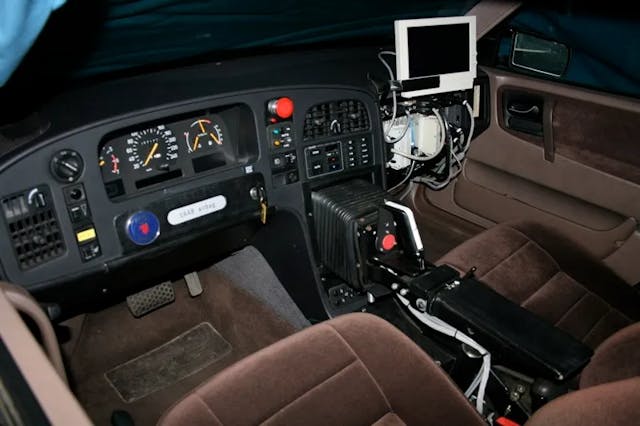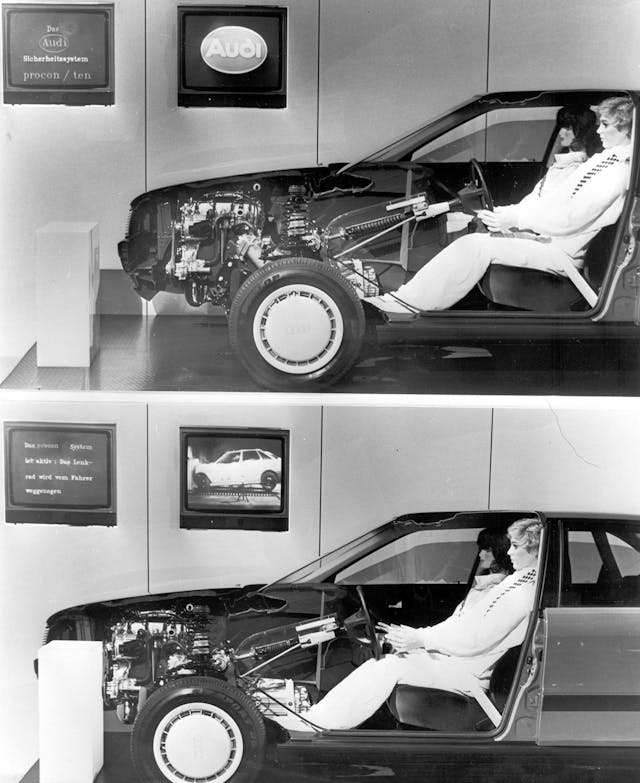The “Pedestrian Scoop” and 6 Other Crazy Car Safety Ideas
Under Britain’s Red Flag Act of 1865, the burgeoning motor carriage was restricted to just two miles per hour in towns and four miles per hour on country roads. What’s more, it was required that every vehicle always had three people with it: one to drive, one to ride shotgun, and a third to walk in front carrying a red flag.
For 30 years, until the act was repealed, this was how car safety was enforced. But if you think that idea was daft, just wait until you see what else automotive inventors came up with.
The Safety Scoop
In 1939, two boffins in Sheffield, U.K. devised the Safety Scoop. Fitted to, or replacing, a car’s front bumper, the spring-loaded device would deploy a large fabric catcher to scoop up any pedestrians who weren’t paying attention.
“When the scoop is open a jaywalker simply can’t get run over—and sometimes that’s more than he deserves,” reported British Pathé. This wasn’t even the first time such a concept had been tried—with a similar setup demonstrated in Germany in 1927. Unsurprisingly, neither version took off.
The Overtaking Aid
Passing a slower-moving car on a single-lane road has always been a potentially risky business. Is the road ahead clear and straight enough? Has the driver ahead noticed you? Is he or she about to turn off or stop? In 1936, in a bid to make overtaking safer, a British inventor came up with a roof-mounted sign so that the driver could indicate to the car behind whether it was safe to pass. However, the idea of taking said responsibility away from the overtaking driver was bonkers, not to mention it simultaneously gave the slower driver authority. Seems to be the perfect road rage recipe.
The Crab Car
Designed to diminish the danger of parking scrapes, the 1938 Crab Car, demonstrated in London, deployed a set of mounted trolley wheels so that the car could be driven sideways into a parking space. Apparently the idea was considered by Britain’s War Office, although perhaps the actual war got in the way of it being adopted. Today, the concept is back with tank-turning EVs such as the Hummer and Hyundai’s amazing axle-articulation. So maybe it was just ahead of its time.
The Tire Trolley
No time to fix a pesky puncture? Then a tire trolley shown in London in 1960 might just be the answer. The device, like the go-jacks used to move cars around shows or workshops, slid under the wheel and tire, allowing the driver to proceed. With what are, essentially, grocery cart casters now replacing one corner of your car, it must have been quite a handful at anything above a walking pace.
The Twin Tire

On the subject of tires, there have been many attempts to reinvent the rubber around things. Truck drivers have long been used to driving dualies with two pairs of wheels and tires on a rear axle, but in the 1980s, Porsche factory racing driver Jaroslav “Jerry” Juhan came up with the concept of having twin tires on a single wheel. The idea was that, in the rain, the channel between the two, narrower, tires would clear water better, while in the dry the contact patch wouldn’t be compromised. JJD Twin Tyres (sic) was the result, and Juhan even managed to get several wheel manufacturers—including ATS, Crimson, and Speedline—to sell compatible wheels, while the tires were available from Avon and Toyo. Despite its benefits, the additional cost and weight of the Twin Tyre setup meant it never made it to the mainstream.
The Joystick Car

If you think Tesla’s yoke is a joke, then what would you make of Saab’s attempt to do away with a steering wheel completely? In the early 1990s, the Swedish firm developed a version of its 9000 with a joystick mounted in the center console. Why? To remove the risk of the driver hitting the steering wheel in an accident. While sound in principle, the problem was that the setup was ridiculously difficult to drive. The stick operation was simple: twist left to go left and right to go right; but with 180 degrees of total movement, steering was super twitchy. The idea was abandoned. On the plus side, some other features of Saab’s “Prometheus” project, such as adaptive cruise control and infra red cameras, would become widely adopted safety features.
Procon Ten

Audi’s Procon Ten system was undoubtedly ingenious, but the arrival of airbags rapidly rendered it obsolete. Procon Ten, released in 1986, used a network of steel cables running around the rear of the engine and connected to the steering column and seat belt mounts. In the event of a frontal collision, as the engine was shunted backwards, the cables pulled the steering wheel away from the driver while the seatbelts were simultaneously tightened. Fitted to the Audi 100/200 and 80/90, it was axed by the time the A4, A8, and A6 arrived to replace them.
***
Check out the Hagerty Media homepage so you don’t miss a single story, or better yet, bookmark it. To get our best stories delivered right to your inbox, subscribe to our newsletters.



The dual tire reminds me of the Goodyear Aquatread in a way.
I believe it was Uniroyal that marketed that “dual” tire here in the U.S. It was promoted as having superior traction in the rain. I don’t think it required a special wheel.
The tiller was not a new invention th1 1990s. A gentleman used to bring his tiller equipped 1903 Oldsmobile to our car meets.
Not exactly safety devices, but I loved the oil slick, smoke screen and missles on the SpyHunter car. Plus you could summon your mobile transport truck repair team with the push of a single button on the steering wheel!
In Canada we call that pedestrian scoop a snow plow.
Fun article. I’ve been driving for over 52 years and never once have I encountered a protester blocking my path, yet so far there are at least four comments here about it. Rather puzzling.
Where you live would probably have something to do with it.
What about the baby crib behind the backseat of the EM Corvairs?
Oops, sorry Paul. Only three referred to protesters. 🙂
When it comes to crazy car safety ideas, you left out NYC’s Vision Zero!
If I have to depend on the reflexes of the driver opening the car catcher on time, and the pedestrian grabbing it properly to hop in—–may as well leave it open and plow the streets in Buffalo
I’m just trying to figure out how my ex-wife ended-up as an audi crash test dummy….😹🤦🏻♂️
Red Green of the Red Green Show installed a jack in the enter of his car so you could lift the whole car and rotate it to get out of a tight parking spot. He also removed the cranks on his truck windows and used a battery drill to raise and lower them. The man was a genius? Check him out if you want a laugh.
American Motors had an idea in the mid 1960’s that used 2 small steering wheels one on each side of the driver’s seat rather than a single wheel.
They could accomplish a full turn without letting go of the wheels.
I remember dual tires featured on the cover of Popular Science a couple of times back in I believe the 70’s. Goodyear finally came out with their Aquatred (and later tripletred) that accomplished essentially the same thing without the need for dual wheels. We bought several sets over the years and they were superior to any other tire available at the time for reducing the risk of hydroplaning.